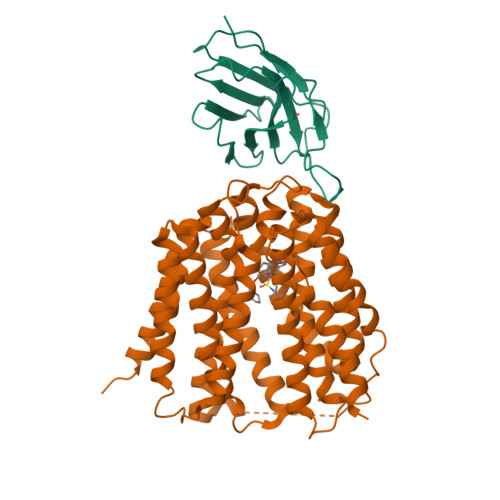Structural basis of thiamine transport and drug recognition by SLC19A3.
Gabriel, F., Spriestersbach, L., Fuhrmann, A., Jungnickel, K.E.J., Mostafavi, S., Pardon, E., Steyaert, J., Low, C.(2024) Nat Commun 15: 8542-8542
- PubMed: 39358356
- DOI: https://doi.org/10.1038/s41467-024-52872-8
- Primary Citation of Related Structures:
8S4U, 8S5U, 8S5W, 8S5Z, 8S61, 8S62, 9G5K - PubMed Abstract:
Thiamine (vitamin B 1 ) functions as an essential coenzyme in cells. Humans and other mammals cannot synthesise this vitamin de novo and thus have to take it up from their diet. Eventually, every cell needs to import thiamine across its plasma membrane, which is mainly mediated by the two specific thiamine transporters SLC19A2 and SLC19A3. Loss of function mutations in either of these transporters lead to detrimental, life-threatening metabolic disorders. SLC19A3 is furthermore a major site of drug interactions. Many medications, including antidepressants, antibiotics and chemotherapeutics are known to inhibit this transporter, with potentially fatal consequences for patients. Despite a thorough functional characterisation over the past two decades, the structural basis of its transport mechanism and drug interactions has remained elusive. Here, we report seven cryo-electron microscopy (cryo-EM) structures of the human thiamine transporter SLC19A3 in complex with various ligands. Conformation-specific nanobodies enable us to capture different states of SLC19A3's transport cycle, revealing the molecular details of thiamine recognition and transport. We identify seven previously unknown drug interactions of SLC19A3 and present structures of the transporter in complex with the inhibitors fedratinib, amprolium and hydroxychloroquine. These data allow us to develop an understanding of the transport mechanism and ligand recognition of SLC19A3.
Organizational Affiliation:
Centre for Structural Systems Biology (CSSB), Notkestraße 85, 22607, Hamburg, Germany.


















